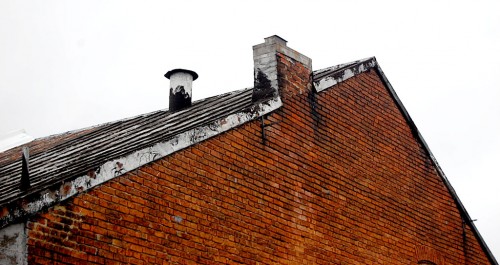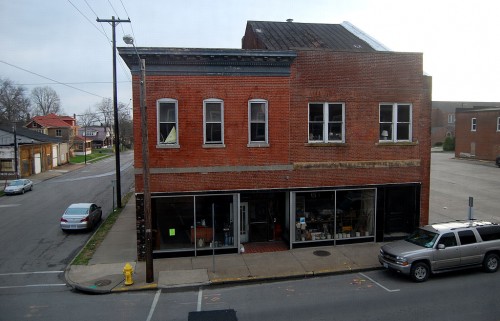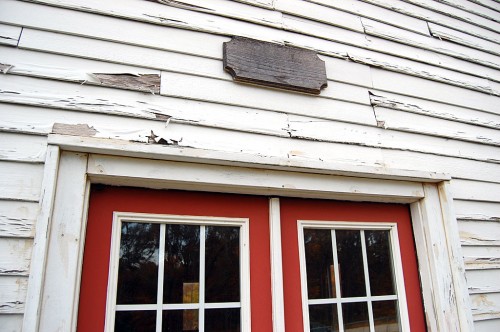 Night before last I was working in the basement and thought I heard a beeping sound like my car’s panic alarm was honking the horn. Every once in awhile, if I bend over just right, other keys in my pocket will hit the key fob button to set it off. I walked upstairs to give a listen. Nope. Nothing in the immediate area, but I COULD hear a faint beeping. (Click on any photo to make it larger.)
Night before last I was working in the basement and thought I heard a beeping sound like my car’s panic alarm was honking the horn. Every once in awhile, if I bend over just right, other keys in my pocket will hit the key fob button to set it off. I walked upstairs to give a listen. Nope. Nothing in the immediate area, but I COULD hear a faint beeping. (Click on any photo to make it larger.)
I categorize threats into two categories:
- Concerns Me
- Doesn’t Concern Me
This fit into the second category and it wasn’t loud enough to keep me awake, so I ignored it.
Do you hear that beeping?
Brother Mark showed up at the house on mid-morning to celebrate Thanksgiving and asked, “Do you hear that beeping?”
I have to confess that I’m missing chunks of frequencies – mostly those that Wife Lila uses to ask me to do things – but I told him that I could hear it faintly. He went out to blow leaves. When he came back, he said he had tried to track down the sound and it appeared to be bouncing off Randy’s house, but not coming FROM the house.
1600 block of Kingsway
 I need to explain how the 1600 block of Kingsway works. We were about the fifth house on the street, and one of the first built in the 1950s. The other homes were decades older.
I need to explain how the 1600 block of Kingsway works. We were about the fifth house on the street, and one of the first built in the 1950s. The other homes were decades older.
If you look at the three ranch-style houses on the north side of Kingsway, we’re the one on the right. The Ailors moved into the one next to us, and the Garners were in the third house down the hill The little house below them was owned by an elderly couple, the McCunes. At the bottom left was the Hale farm; they owned the pasture behind our house.
Directly across from us lived the Tinkers. Down the hill from them was a two-story house owned by John and Mary Gray. For some reason, they fixed up a chicken house behind the big house and moved into there, leaving the big house as rental property occupied by folks we never bothered to learn names for. Eventually, the house was bought by Randy, a Cape firefighter. He was there long enough for it to be dubbed “Randy’s house.” He sold it and now it’s destined for demolition.
It’s always going to be Tinkers’
 So, even though the Tinkers have been dead for years and Bill and Rhonda Boltens (great neighbors, by the way) have been living there for longer than I can remember, it’s probably always going to be “over at Tinkers” to us.
So, even though the Tinkers have been dead for years and Bill and Rhonda Boltens (great neighbors, by the way) have been living there for longer than I can remember, it’s probably always going to be “over at Tinkers” to us.
Anyway, now that you have the layout in your mind -or, are totally confused – let’s get back to the beeping story.
Doesn’t seem to be inside
 The noise got louder the closer we got to Randy’s house, but it didn’t appear to be coming FROM the house. You couldn’t hear it from behind the house. It felt like it was bouncing OFF the house.
The noise got louder the closer we got to Randy’s house, but it didn’t appear to be coming FROM the house. You couldn’t hear it from behind the house. It felt like it was bouncing OFF the house.
Let’s check the Garner house
 I walked across the street to the old Garner house. I could see a dog inside, so I knocked on the door. A coworker in Florida posted an account last week about how she never opens the door for a stranger. Others chimed in with stories about how they always keep a gun at the door. They obviously spend all their time listening to The All Fear All the Time Network. With that in mind, I wondered if I’d get an answer.
I walked across the street to the old Garner house. I could see a dog inside, so I knocked on the door. A coworker in Florida posted an account last week about how she never opens the door for a stranger. Others chimed in with stories about how they always keep a gun at the door. They obviously spend all their time listening to The All Fear All the Time Network. With that in mind, I wondered if I’d get an answer.
After a couple of raps, and much dog barking, a young woman came to the door. I identified myself and said I was staying with Mother up the street. “I read your column,” she volunteered. That always feels good to hear.
I told her Mark and I were tracking down a mystery. “You mean the beeping? It’s not coming from here. I noticed it when I got home around lunchtime yesterday.” We told her we’d let her know what we found.
Past the old McCune place
 We walked down the hill from what had been the McCune property and noticed that a lot of the homeowners in what used to be a pasture I roamed and camped in when I was 10 or 12 had done a lot of nice landscaping. Fortunately, the area behind our house and the next door neighbor has been left to go wild, proving habitat for all kinds of creatures, plus preserving the rural feel we’ve had since before we were in the city limits.
We walked down the hill from what had been the McCune property and noticed that a lot of the homeowners in what used to be a pasture I roamed and camped in when I was 10 or 12 had done a lot of nice landscaping. Fortunately, the area behind our house and the next door neighbor has been left to go wild, proving habitat for all kinds of creatures, plus preserving the rural feel we’ve had since before we were in the city limits.
The sound didn’t get stronger, and it still seemed to be directional. If we moved off to the left or right, it got fainter. I thought at one time that the sound was stronger coming from the direction away from the house, but Mark convinced me that I was hearing things.
I felt like I was back taking my draft physical. They put a bunch of guys wearing only our underwear in a small, dark room, put headphones on our heads and handed us a box with a button on it. “When you hear a tone, press the button,” we were ordered by someone who looked at us like we were a lower form of life. I had my finger on the button waiting to hear something. Nothing. We all started looking at each other and shrugging our shoulders. Then, we all started pushing the button at random. Interestingly enough, we all passed.
Is it the fuzzy-tailed rat?
 When we got back up the hill, Mark noticed that a tree in front of the house had a squirrel’s nest in it. “Maybe the fuzzy-tailed rat (Mark doesn’t like squirrels ever since they got in his attic) carried something up into his nest.” We wandered around the tree and ruled the fuzzy-tailed rat blameless. Well, at least I did. Mark still thinks one was the second shooter on the Grassy Knoll.
When we got back up the hill, Mark noticed that a tree in front of the house had a squirrel’s nest in it. “Maybe the fuzzy-tailed rat (Mark doesn’t like squirrels ever since they got in his attic) carried something up into his nest.” We wandered around the tree and ruled the fuzzy-tailed rat blameless. Well, at least I did. Mark still thinks one was the second shooter on the Grassy Knoll.
By this time, it was Hungry O’Clock and we had to chow down on some great slow-cooked roast beef and all the fixin’s. We had more desserts than any three people can eat in two weeks (but we’re gonna try). Then, my schedule showed it was time for a 37-minute nap (I had missed my 22-minute 11 o’clock nap, so I was due for an extension).
Smoke alarm theory
 Shortly before dark, we piled in the car and cruised up all the streets in a one-mile radius trying to find some house that was in line-of-sight with Randy’s that was making a noise that could be hitting his old house and reflecting off it. Zip. Zero. Nada.
Shortly before dark, we piled in the car and cruised up all the streets in a one-mile radius trying to find some house that was in line-of-sight with Randy’s that was making a noise that could be hitting his old house and reflecting off it. Zip. Zero. Nada.
One last theory: Mark did a Google search on beeps and found a reference that “This alarm incorporates the internationally recognized horn signal for evacuation. During alarm mode, the horn produces three short beeps, followed by a two-second pause and then repeats. This pattern is somewhat different than the previous alarm sound, which continually beeped.”
We didn’t think it was a smoke alarm because it sounded like it was a lower frequency than most smoke alarms and it wasn’t sounding “beep pause beep pause beep” in a continuous series . We know power has been off in the house for quite awhile, so it’s possible that an alarm has drained its battery, particularly with temperatures dropping to freezing. If the new standard is for alarms to broadcast three beeps now, maybe that’s it.
If it’s still going off tomorrow, we’ll see if we can get into the house or listen at a window to see if it’s coming from the inside. Otherwise, I’m going to invoke Category Two and ignore it.



































































